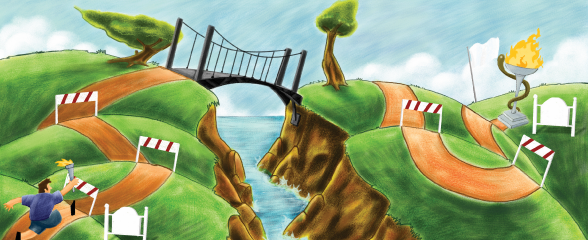A quick guide to surviving the dreaded “Why aren’t our scores increasing?” question
Know that feeling? You are about to present the latest passenger research findings to your colleagues and the news is bad: satisfaction levels have not increased at all, or worse they have dropped despite the new customer service initiative you just implemented. And you don’t really know why. So you are just sitting there dreading the moment your boss will ask you point blank why satisfaction levels aren’t up, expecting a detailed answer from you.
If you recognize that feeling then this post is for you. It is meant as a survival guide based on my nearly 10 years of experience helping managers in airports all over the world analyse their customer experience data to answer this exact question. I hope to provide you with some key questions to consider that I have found useful in prompting a constructive discussion with your colleagues the next time you are asked why your scores aren’t increasing.
- You lack insight into what is actually causing dissatisfaction and how to fix it
First of all, it is important to recognize that you may simply lack the data to be able to answer. If your survey provides a simplistic overview of satisfaction levels that doesn’t reflect the complexity of the passenger experience at your airport you will find it hard to identify the root causes of dissatisfaction. A simple way of seeing if this is your case is asking yourself how often you have to tell colleagues “Sorry that question isn’t asked in the research” or “Sorry we need to conduct additional surveys to find out”. To be able to answer your colleagues and provide detailed solutions to improve the passenger experience you need a research tool that paints a sufficiently detailed picture of the passenger experience at your airport.
Key questions to consider: Is our passenger experience monitoring system detailed enough? Do we need to conduct extra research to identify the root causes of satisfaction?
- You are not making the most of your existing data
Many airports don’t have their own market research team so passenger surveys are managed by members of the marketing or operational teams. Quite often the person in charge doesn’t have the time or experience to perform a detailed analysis of results amidst all of the other projects they are managing and may not be using the data to its fullest. Identifying root causes of dissatisfaction is complex and requires a thorough analysis of data that is best conducted by an experienced data analyst.
Key questions to consider: Do I feel confident analysing & presenting research findings to my colleagues? Would a more detailed analysis of our data be beneficial to the airport?
- Your facilities are operating over or close to capacity
Sometimes the hard truth is that you may have reached the highest level of satisfaction you can expect to achieve in existing facilities. If your airport is operating near or over capacity then even maintaining your level of satisfaction is a challenge, especially if traffic is increasing. In this situation you need to manage your colleagues’ expectations and focus the discussion on how to limit the damage of traffic peaks to your passenger experience.
Key questions to consider: Were our results affected by a peak in traffic? Have key passenger processes also experienced a decrease in satisfaction levels? Has our performance decreased or have expectation levels increased? How long do passengers expect to wait and are we meeting this expectation in our current facilities?
- Facilities were designed for different purposes or aircraft
Most airports are a mix of old and new facilities and it is hard to achieve similar levels of performance across all terminals. Splitting your results by terminal will help you identify which parts of the airport are underperforming and explain to your colleagues why the overall airport score is being dragged down by older facilities. This will help you manage expectations as to what can reasonably be achieved and start a constructive conversation on how to limit the damage caused by older parts of the airport.
Key questions to consider: Were satisfaction levels lower in our older facilities? Did we encounter any operational issues in certain terminals / concourses during the days on which fieldwork was carried out? What do different segments want to do while at the airport and are we providing them with the facilities that they want?
- Lack of investment over time leading to maintenance and ambience issues
If you want to be able to increase global satisfaction levels you need to make sure that you are performing well for the key drivers of satisfaction (cleanliness, ambience, washrooms). If your ambience and cleanliness scores are stagnating chances are your overall satisfaction score is as well. You need to make sure that you are focusing enough effort on maintaining existing facilities since passengers will not forgive torn seating, broken washrooms or dirty carpets.
Key questions to consider: Are our ambience and cleanliness scores decreasing and which part of the airport are they decreasing in? Do current cleaning and maintenance schedules reflect passenger usage patterns? Are parts of our airport starting to feel run down? What defines our airport’s ambience and drives satisfaction?
- Commercial or airline initiatives are damaging the ease of use of your facilities
Airports tend to be short on space and can quickly become packed with advertising, airline signage, etc… All this clutter will quickly get in the way of your signage and make navigating your airport more complicated. And clutter is the enemy of ambience, making your terminal feel less enjoyable and preventing overall satisfaction levels from rising even in newer facilities. Regularly walking around your terminals to put yourself in your passengers’ shoes will help you see if this can be preventing scores from increasing.
Key questions to consider: Does our terminal feel cluttered? Are our wayfinding scores decreasing? What can we get rid of in the terminal?
- Airport management overly prioritises operational processes at the expense of the passenger experience
Airports have a natural tendency to believe focusing on processes is the solution to improve the passenger experience. While processes can be a major cause of dissatisfaction they alone will not make passengers love your airport (nobody ever says “that was a great airport – best queue ever!”). So you need to make sure that you are creating an experience that is great overall. If your processes are improving while the rest of the experience isn’t this is generally a good sign that you need to review your customer experience strategy.
Key questions to consider: Are our processes rated higher than drivers of satisfaction such as ambience, cleanliness or the washrooms? Is satisfaction with processes increasing while performance for drivers is stable or decreasing? What sort of experience do our key segments want and are we prioritizing our efforts to deliver it to them?
- Quality standards are too low across the airport
All it takes is one negative experience to damage a passenger’s perception of your airport. To successfully improve passenger satisfaction levels you need to be performing well all the time. The only way to achieve this is to make sure that everyone working in the airport understands the quality standards you expect them to reach and are sufficiently motivated and proud of the airport to do so every time they come to work.
Key questions to consider: Are our quality standards high enough? Do they reflect the actual passenger experience? Are we creating a sense of pride of working in our airport?
From my experience, most of the frustration and dread of not being able to provide colleagues with a clear answer as to why satisfaction levels are not increasing stems from lacking the right data. So your starting point should always be to ask yourself whether or not the data you have is sufficient to reach a meaningful conclusion and being willing to say that you cannot answer until you have more data.
If your data is not detailed enough you will find it very hard to answer many of the questions suggested above and provide colleagues with actual solutions for improving the passenger experience. On the other hand, if your customer satisfaction data paints a complete picture of the passenger experience at your airport you will find that answering your colleagues’ questions becomes easier.
And who knows, someday you might even look forward to having to answer the dreaded “Why aren’t our scores increasing?” question.



